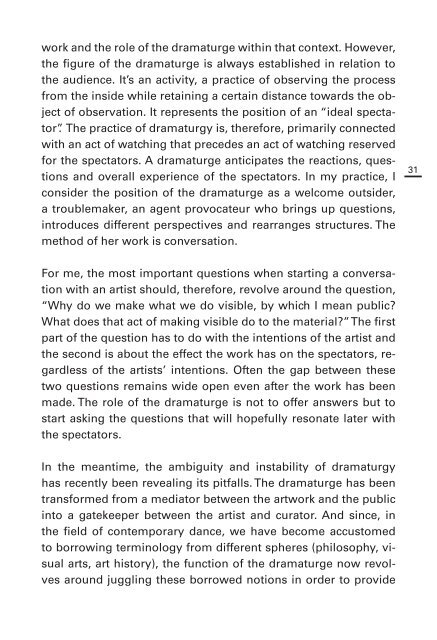Laboratory on Feedback in Artistic Processes 3
In its third edition the "Laboratory on Feedback in Artistic Processes" reflects on "Responses" within performing arts. The results of the previous Labs highlighted the need to take a closer look at the complexity and often subtle implications of feedback within the the artistic process itself. How do artist organise feedback and how do they process it? Who they want feedback from and what are its different roles? How can describe these relationships, and how does it shpae the artistic work? This booklet presents the different views on and experiences of feedback practices that were elaborated during the lab along the beforementioned questions and the insightfull contributions of its participants. Underpinning the following pages, three thematic fields have emerged: the impacts of feedback, feedback as a tool, and practicalities and contexts of feedback.
In its third edition the "Laboratory on Feedback in Artistic Processes" reflects on "Responses" within performing arts. The results of the previous Labs highlighted the need to take a closer look at the complexity and often subtle implications of feedback within the the artistic process itself. How do artist organise feedback and how do they process it? Who they want feedback from and what are its different roles? How can describe these relationships, and how does it shpae the artistic work?
This booklet presents the different views on and experiences of feedback practices that were elaborated during the lab along the beforementioned questions and the insightfull contributions of its participants. Underpinning the following pages, three thematic fields have emerged: the impacts of feedback, feedback as a tool, and practicalities and contexts of feedback.
You also want an ePaper? Increase the reach of your titles
YUMPU automatically turns print PDFs into web optimized ePapers that Google loves.
work and the role of the dramaturge with<strong>in</strong> that c<strong>on</strong>text. However,<br />
the figure of the dramaturge is always established <strong>in</strong> relati<strong>on</strong> to<br />
the audience. It’s an activity, a practice of observ<strong>in</strong>g the process<br />
from the <strong>in</strong>side while reta<strong>in</strong><strong>in</strong>g a certa<strong>in</strong> distance towards the object<br />
of observati<strong>on</strong>. It represents the positi<strong>on</strong> of an “ideal spectator”.<br />
The practice of dramaturgy is, therefore, primarily c<strong>on</strong>nected<br />
with an act of watch<strong>in</strong>g that precedes an act of watch<strong>in</strong>g reserved<br />
for the spectators. A dramaturge anticipates the reacti<strong>on</strong>s, questi<strong>on</strong>s<br />
and overall experience of the spectators. In my practice, I<br />
c<strong>on</strong>sider the positi<strong>on</strong> of the dramaturge as a welcome outsider,<br />
a troublemaker, an agent provocateur who br<strong>in</strong>gs up questi<strong>on</strong>s,<br />
<strong>in</strong>troduces different perspectives and rearranges structures. The<br />
method of her work is c<strong>on</strong>versati<strong>on</strong>.<br />
31<br />
For me, the most important questi<strong>on</strong>s when start<strong>in</strong>g a c<strong>on</strong>versati<strong>on</strong><br />
with an artist should, therefore, revolve around the questi<strong>on</strong>,<br />
“Why do we make what we do visible, by which I mean public?<br />
What does that act of mak<strong>in</strong>g visible do to the material?” The first<br />
part of the questi<strong>on</strong> has to do with the <strong>in</strong>tenti<strong>on</strong>s of the artist and<br />
the sec<strong>on</strong>d is about the effect the work has <strong>on</strong> the spectators, regardless<br />
of the artists’ <strong>in</strong>tenti<strong>on</strong>s. Often the gap between these<br />
two questi<strong>on</strong>s rema<strong>in</strong>s wide open even after the work has been<br />
made. The role of the dramaturge is not to offer answers but to<br />
start ask<strong>in</strong>g the questi<strong>on</strong>s that will hopefully res<strong>on</strong>ate later with<br />
the spectators.<br />
In the meantime, the ambiguity and <strong>in</strong>stability of dramaturgy<br />
has recently been reveal<strong>in</strong>g its pitfalls. The dramaturge has been<br />
transformed from a mediator between the artwork and the public<br />
<strong>in</strong>to a gatekeeper between the artist and curator. And s<strong>in</strong>ce, <strong>in</strong><br />
the field of c<strong>on</strong>temporary dance, we have become accustomed<br />
to borrow<strong>in</strong>g term<strong>in</strong>ology from different spheres (philosophy, visual<br />
arts, art history), the functi<strong>on</strong> of the dramaturge now revolves<br />
around juggl<strong>in</strong>g these borrowed noti<strong>on</strong>s <strong>in</strong> order to provide


















